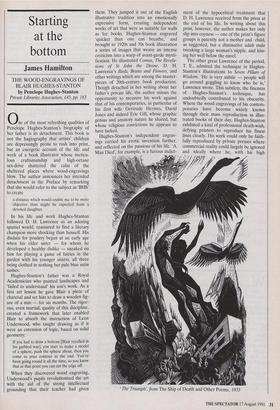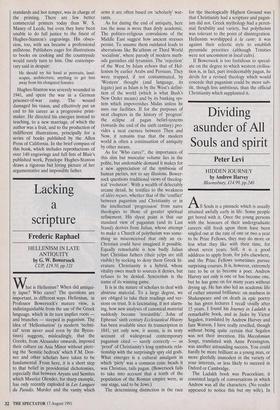Starting at the bottom
James Hamilton
THE WOOD-ENGRAVINGS OF BLAIR HUGHES-STANTON by Penelope Hughes-Stanton Private Libraries Association, £45, pp. 183 One of the most refreshing qualities of Penelope Hughes-Stanton's biography of her father is its detachment. This book is not the hagiography that artists' children are depressingly prone to rush into print, but an energetic account of the life and work of a book illustrator whose meticu- lous craftsmanship and high-octane sex-drive shattered the calm of the sheltered places where wood-engravings blow. The author announces her intended detachment in the Preface by remarking that she would refer to the subject as `13HS' to create
a distance which would enable me to be more objective than might be expected from a devoted daughter.
In his life and work Hughes-Stanton followed D. H. Lawrence as an adoring spaniel would, reassured to find a literary champion more shocking than himself. His disdain for prudery began at an early age when his elder sister — for whom he developed a healthy dislike — sneaked on him for playing a game of fairies in the garden with his younger sisters, all three being clothed in nothing but pale blue satin sashes.
Hughes-Stanton's father was a Royal Academician who painted landscapes and 'failed to understand' his son's work. As a first art lesson he gave Blair a piece of charcoal and set him to draw a wooden fig- ure of a nun — for six months. The rigor- ous, even martial, quality of this discipline, created a framework that later enabled Blair to absorb the instruction of Leon Underwood, who taught drawing as if it were an extension of logic, based on solid geometry:
If you had to draw a bottom [Blair recalled in his garbled way], you start to make a model of a sphere, push the sphere about, then you come to your contour in the end. You've been going round it all the time, so you know that at that point you can cut the edge off.
When they discovered wood engraving, Underwood's pupils revolutionised the art with the aid of the strong intellectual grounding that their teacher had given
them. They jumped it out of the English illustrative tradition into an emotionally expressive form, creating independent works of art that were as suitable for walls as for books. Hughes-Stanton engraved 'quicker than one can breathe,' and brought to 1920s and 30s book illustration a series of images that weave an intense eroticism into a warp of avant-garde mysti- fication. He illustrated Comas, The Revela- tions of St John the Divine, D. H. Lawrence's Birds, Beasts and Flowers, and other writings which are among the master- pieces of 20th-century book production. Though detached in her writing about her father's private life, the author misses the opportunity to measure his work against that of his contemporaries, in particular of his first wife Gertrude Hermes, David Jones and indeed Eric Gill, whose graphic genius and amatory nature he shared, but whose religious convictions he appears to have lacked.
Hughes-Stanton's independent engrav- ings carried his erotic invention further, and reflected on the passions of his life. 'A Man Died', for example, is a furious indict-
ment of the hypocritical treatment that D. H. Lawrence received from the press at the end of his life. In writing about this print, however, the author makes her only slip into coyness — one of the print's figure groups is patently not a mother and child, as suggested, but a diminutive adult male tweaking a large woman's nipple, and kiss- ing her well below the navel.
The other great Lawrence of the period, T. E., admired the technique in Hughes- Stanton's illustrations to Seven Pillars of Wisdom. 'He is very subtle — people will go around goggling to know who he is,' Lawrence wrote. This subtlety, the fineness of Hughes-Stanton's technique, has undoubtedly contributed to his obscurity. Where the wood engravings of his contem- poraries have become widely known through their mass reproduction in illus- trated books of their day, Hughes-Stanton exhibited a kind of professional death-wish, defying printers to reproduce his finest lines clearly. His work could only be faith- fully reproduced by private presses where commercial reality could largely be ignored and ideally where he, with his high ' The Triumph', from The Ship of Death and Other Poems, 1933
standards and hot temper, was in charge of the printing. There are few better commercial printers today than W. S. Maney of Leeds, but even they have been unable to do full justice to the finest of Hughes-Stanton's engravings. His obses- sion, too, with sex became a professional millstone. Publishers eager for. illustrations to books on cooking and the countryside would rarely turn to him. One contempo- rary said in despair: He should try his hand at portraits, land- scapes, architecture, anything to get him away from his elongated females.
Hughes-Stanton was severely wounded in 1941, and spent the war in a German prisoner-of-war camp. The wound damaged his vision, and effectively put an end to his career as a progressive print- maker. He directed his energies instead to teaching, to a new marriage, of which the author was a fruit, and to the production of indifferent illustrations, principally for a series of books published by the Allen Press of California. In the brief compass of this book, which includes reproductions of over 140 engravings and full lists of Blair's published work, Penelope Hughes-Stanton draws a rigorous but loving picture of her argumentative and impossible father.



















































 Previous page
Previous page